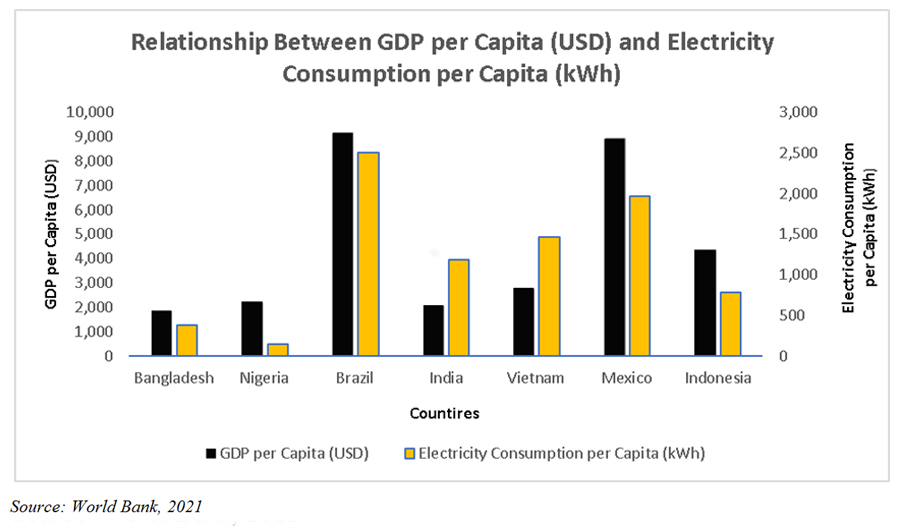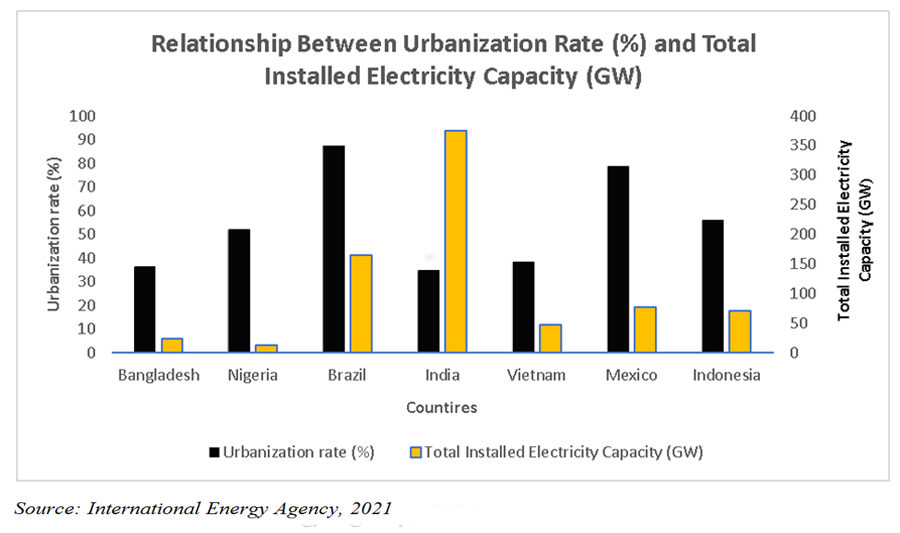
Electricity consumption and sustainable energy for economic prosperity
Shadab Zahin Sarker and Sayed Ashraful Basher | Friday, 26 January 2024
Electricity is often viewed as an indicator of a nation's progress. A reliable and abundant electricity supply can improve life as we know it. In Bangladesh's growth process, electricity is crucial to power its industry and improve the quality of life of its citizens. Like many developing countries, Bangladesh struggles to provide dependable and accessible energy.
It is generally observed that countries with higher GDP per capita (average income of a country's residents) tend to have improved electricity access and increased electricity consumption per capita. In recent years, Bangladesh has experienced extraordinary economic progress. Its GDP per capita has been expanding rapidly due to advancements across several economic sectors. Over the years, the electricity consumption per household in the country has substantially increased as well. Here, the implication is that there is a clear relationship between GDP per capita and electricity consumption per capita of a nation. The total installed electricity capacity reflects a nation's readiness for economic expansion. A developing country that invests in building a robust electricity infrastructure signals its intent to attract investments and foster industrialization. A growing capacity indicates the potential for increased economic activity. For instance, a developing nation may embark on a massive electrification project, expanding its electricity
The total installed electricity capacity reflects a nation's readiness for economic expansion. A developing country that invests in building a robust electricity infrastructure signals its intent to attract investments and foster industrialization. A growing capacity indicates the potential for increased economic activity. For instance, a developing nation may embark on a massive electrification project, expanding its electricity  generation capabilities. This expansion allows industries to operate at full capacity and encourages new businesses to come into operation. It also attracts foreign investors seeking stable and reliable power sources. Bangladesh invests in its power infrastructure as one of its primary economic growth initiatives. To satisfy the expanding demand, the nation has been attempting to increase its total installed capacity for energy. This growth is necessary to draw in capital, foster industrialisation, and promote economic diversification. The rates of industrialisation and urbanisation are closely linked to electricity consumption. As developing countries urbanise and industrialise, their electricity needs rise in parallel. Bangladesh is rapidly urbanising, with a sizable section of the country's people relocating in urban locations in quest of better prospects. Urban areas, where access is more readily available than rural areas, are experiencing an increase in demand for electricity due to this urbanisation trend. Bangladesh's economic development is greatly influenced by industrialisation. Notably, the nation's ready-to-wear industry has expanded tremendously and makes a sizable contribution to its export revenue. These businesses depend heavily on electricity, and maintaining a steady energy supply is essential to keep this boom going.
generation capabilities. This expansion allows industries to operate at full capacity and encourages new businesses to come into operation. It also attracts foreign investors seeking stable and reliable power sources. Bangladesh invests in its power infrastructure as one of its primary economic growth initiatives. To satisfy the expanding demand, the nation has been attempting to increase its total installed capacity for energy. This growth is necessary to draw in capital, foster industrialisation, and promote economic diversification. The rates of industrialisation and urbanisation are closely linked to electricity consumption. As developing countries urbanise and industrialise, their electricity needs rise in parallel. Bangladesh is rapidly urbanising, with a sizable section of the country's people relocating in urban locations in quest of better prospects. Urban areas, where access is more readily available than rural areas, are experiencing an increase in demand for electricity due to this urbanisation trend. Bangladesh's economic development is greatly influenced by industrialisation. Notably, the nation's ready-to-wear industry has expanded tremendously and makes a sizable contribution to its export revenue. These businesses depend heavily on electricity, and maintaining a steady energy supply is essential to keep this boom going.
Bangladesh and other developing countries often face several challenges in pursuing economic growth through increased electricity consumption. While the relationship between electricity consumption and economic growth in developing countries like Bangladesh is clear, it's essential to approach this issue critically. Electricity efficiency, technological adoption, and sustainable energy practices are critical for long-term economic development, coinciding with UN Sustainable Development Goals (SDGs) 7 and 12. Simply increasing electricity consumption without addressing these aspects may lead to environmental degradation and energy inefficiency. The country should prioritise sustainable practices in energy production and consumption, as well as efficient use of electricity, technological adoption, and energy mix diversification.
Bangladesh faces challenges that include funding infrastructure projects, addressing energy inefficiencies, and ensuring equitable access to electricity, especially in rural areas. The energy sector's reliance on fossil fuels can exacerbate environmental issues, contributing to climate change and air pollution. Moreover, like many other developing nations, Bangladesh relies heavily on energy imports for electricity generation, exposing the economy to macroeconomic risks. This dependence can lead to trade imbalances, trade deficits, and volatile global energy markets. The financial burden of subsidising energy imports can strain the government's fiscal health, potentially increasing public debt. Additionally, dependence on energy imports raises concerns about energy security, as disruptions in the global supply chain or geopolitical tensions can cause sudden shortages and price spikes. Developing nations like Bangladesh should prioritise clean and renewable energy sources to mitigate these risks. Investing in renewable energy sources, enhancing energy efficiency measures, and diversifying the energy mix can not only balance economic development and environmental sustainability but also help reduce dependence on volatile global energy markets, improve energy security, and promote long-term macroeconomic stability.
Nuclear energy is a reliable and clean source of power. With the proper safety measures, it can make a big difference in the country's energy mix by adding stable base power to help renewable sources that operate often. Bangladesh's first nuclear power plant is the Rampal Power Plant, which is in the country's southwestern part. As a critical component of the nation's electrical power mix, nuclear energy is a stable and reliable way to get electricity.
Furthermore, Bangladesh has been utilising solar energy to provide electricity to remote areas. Off-grid solar solutions and solar energy systems have been executed to provide sustainable access to electricity. Solar home systems and large-scale solar programmes play a significant role in the nation's endeavors to decrease reliance on conventional fuels.
Moreover, because of their topography level, specific areas in Bangladesh, especially in rural regions, are suitable for applying wind energy. Located in humid regions, wind turbines make a significant contribution to the endeavour of generating electricity in rural areas. Wind power campaigns hold the potential to contribute to the overall renewable energy capacity and generate clean electricity. In addition to lowering the environmental impact, this renewable energy source provides an economical way of supplying power to rural areas.
Another example of renewable energy is hydroelectric power. This dependable and consistent power supply improves the standard of living and simplifies agricultural operations. Bangladesh's numerous rivers offer substantial potential for hydroelectric power generation. The Kaptai River Plant, centered in the Chittagong Hill Tracts, is vital to Bangladesh's energy infrastructure. By capitalising on the heat generated by the process of circulating water, this system makes an essential contribution to the electrification of rural areas.
The relationship between electricity consumption and economic growth in developing countries is complex and versatile. Despite the positive correlation between increased electricity consumption and economic development, addressing environmental concerns and heavy reliance on energy imports is challenging. Bangladesh's journey towards sustainable energy in rural areas involves a blend of nuclear, solar, wind, and hydroelectric power, each contributing uniquely to the nation's electrification goals. Guidelines and regulations should concentrate on stimulating energy efficiency, using renewable energy, and developing new technologies for the best use of electricity.
Shadab Zahin Sarker and Sayed Ashraful Basher are undergraduate students, department of economics & social sciences, Brac University.
shadab.zahin.sarker@g.bracu.ac.bd; sayed.ashraful.basher@g.bracu.ac.bd